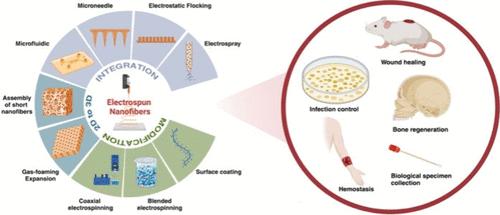当前位置:
X-MOL 学术
›
Acc. Mater. Res.
›
论文详情
Our official English website, www.x-mol.net, welcomes your
feedback! (Note: you will need to create a separate account there.)
Advances in Electrospun Nanofibers: Versatile Materials and Diverse Biomedical Applications
Accounts of Materials Research ( IF 14.0 ) Pub Date : 2024-07-15 , DOI: 10.1021/accountsmr.4c00145 Chenlong Wang 1 , Yajuan Su 1 , Jingwei Xie 1
Accounts of Materials Research ( IF 14.0 ) Pub Date : 2024-07-15 , DOI: 10.1021/accountsmr.4c00145 Chenlong Wang 1 , Yajuan Su 1 , Jingwei Xie 1
Affiliation

|
Electrospining has emerged as a versatile and transformative technique for the fabrication of nanofiber materials, which have been shown to be promising in applications across various biomedical domains. Cutting-edge research in electrospinning technology is centered on enhancing versatility, efficiency, and functionality of electrospun nanofibers through several key facets. These include the development of advanced materials, with ongoing exploration into novel polymer systems spanning synthetic polymers, natural polymers, and polymer blends to broaden the spectrum of achievable properties and functions. Additionally, there is significant emphasis on controlling fiber size, morphology, and alignment. Surface functionalization with bioactive molecules, drugs, or targeting ligands enhances specific functionalities like antimicrobial properties, cell adhesion, or targeted drug delivery. Furthermore, researchers are delving into the creation of multifunctional hybrid structures by integrating electrospinning with other fabrication techniques such as 3D printing, microfluidics, or layer-by-layer assembly, enabling customized properties and functionalities. Lastly, there is a strong fucus on biomedical applications, leveraging electrospun nanofibers for tissue engineering, wound healing, drug delivery, and biosensing, aiming to develop biocompatible and bioresorbable scaffolds with controlled structural and bioactive cues to promote tissue regeneration and repair.
中文翻译:

静电纺纳米纤维的进展:多功能材料和多样化的生物医学应用
静电纺丝已成为一种用于制造纳米纤维材料的多功能和变革性技术,已被证明在各个生物医学领域的应用中具有广阔的前景。静电纺丝技术的前沿研究集中在通过几个关键方面增强静电纺丝纳米纤维的多功能性、效率和功能。其中包括先进材料的开发,不断探索涵盖合成聚合物、天然聚合物和聚合物共混物的新型聚合物系统,以拓宽可实现的性能和功能的范围。此外,还非常重视控制纤维尺寸、形态和排列。使用生物活性分子、药物或靶向配体进行表面功能化可增强特定功能,如抗菌特性、细胞粘附或靶向药物输送。此外,研究人员正在深入研究通过将静电纺丝与 3D 打印、微流体或逐层组装等其他制造技术相结合来创建多功能混合结构,从而实现定制的特性和功能。最后,重点关注生物医学应用,利用电纺纳米纤维进行组织工程、伤口愈合、药物输送和生物传感,旨在开发具有受控结构和生物活性线索的生物相容性和生物可吸收支架,以促进组织再生和修复。
更新日期:2024-07-15
中文翻译:

静电纺纳米纤维的进展:多功能材料和多样化的生物医学应用
静电纺丝已成为一种用于制造纳米纤维材料的多功能和变革性技术,已被证明在各个生物医学领域的应用中具有广阔的前景。静电纺丝技术的前沿研究集中在通过几个关键方面增强静电纺丝纳米纤维的多功能性、效率和功能。其中包括先进材料的开发,不断探索涵盖合成聚合物、天然聚合物和聚合物共混物的新型聚合物系统,以拓宽可实现的性能和功能的范围。此外,还非常重视控制纤维尺寸、形态和排列。使用生物活性分子、药物或靶向配体进行表面功能化可增强特定功能,如抗菌特性、细胞粘附或靶向药物输送。此外,研究人员正在深入研究通过将静电纺丝与 3D 打印、微流体或逐层组装等其他制造技术相结合来创建多功能混合结构,从而实现定制的特性和功能。最后,重点关注生物医学应用,利用电纺纳米纤维进行组织工程、伤口愈合、药物输送和生物传感,旨在开发具有受控结构和生物活性线索的生物相容性和生物可吸收支架,以促进组织再生和修复。































 京公网安备 11010802027423号
京公网安备 11010802027423号